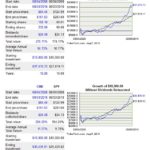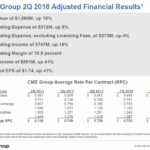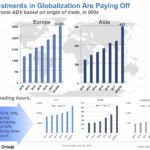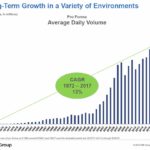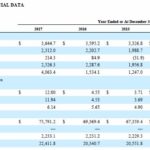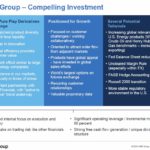Contents
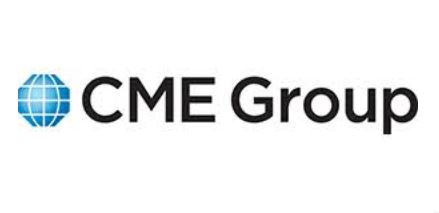 Summary
Summary
- Stock screeners have shortcomings which can result in investors overlooking opportunities.
- This company was founded in 1898 but only went public in 2002.
- It operates in a highly competitive industry and faces considerably regulatory scrutiny.
- Investors seeking to minimize credit risk will likely find this company to be appealing.
- This stock is certainly not at bargain levels but is not outrageously overvalued given its growth potential.
- I intend to initiate a position in the ‘side accounts’ in the FFJ Journey Portfolio within the next 72 hours.
Introduction
In today’s article I cover a company which is likely overlooked by many investors. The reason for this is that many investors are seeking a respectable dividend yield and they rely heavily on stock screeners. The drawback with this method of identifying investment opportunities is that the stock screeners report dividend yield on the basis of ‘regular’ dividends and disregard ‘special dividends’. This is why the company analyzed in this article will be excluded from search results if you were to perform a search today and one of your search parameters calls for a dividend yield in excess of 2%.
This company instituted a variable dividend policy in 2012 in which it sweeps excess cash to shareholders. Subsequent to instituting this policy, this company has distributed a ‘special dividend’ per share of $1.9, $2.6, $2, $2.9, $3.25, and $3.5 in FY2012 – 2017.
Sometimes you just have to love stock screeners for what they DON’T report!
This company operates in a highly competitive and very highly regulated industry. It, however, is far larger than members of its peer group which provides it with competitive advantages.
In its most recent quarter, this company reported:
- continued increase in global activity with non-U.S. average daily volume up 14% compared with 2Q17;
- Double-digit YoY growth for 5 of 6 product lines, ranging between 11% and 42%;
- Q2 Asian average daily volume up 30% with particular strength in specific products growing 77%, 50% and 41%;
- Q2 European average daily volume up 9%.
I will readily admit the stock is not inexpensive. It has, however, retraced ~7% from its recent high and is now valued at a level that I consider to be reasonable. I also think it is NOT grossly expensive given its growth potential.
I intend to initiate a position in the ‘side accounts’ in the FFJ Journey Portfolio within the next 72 hours.
Business Overview
CME Group (NASDAQ: CME) serves the risk management and investment needs of customers worldwide. It offers the widest range of global benchmark products across all major asset classes, with contracts listed on CME, CBOT, NYMEX, COMEX and CME Europe. Investors can trade futures and options based on:
- interest rates;
- equity indexes;
- energy;
- foreign exchange;
- energy;
- agricultural commodities;
- metals.
It was founded in 1898 as a not-for-profit corporation but in 2000 it demutualized and became a shareholder-owned corporation.
In 2002, CME completed its IPO (initial public offering) and in 2007 it merged with CBOT Holdings, Inc. and was renamed CME Group. In connection with the merger, CME acquired the CBOT exchange which is a leading marketplace for trading agricultural and U.S. Treasury futures as well as options on futures
In 2008, CME merged with NYMEX Holdings, Inc. and acquired NYMEX and COMEX. On NYMEX, customers primarily trade energy futures and options contracts, including contracts for crude oil, natural gas, heating oil and gasoline. On COMEX, customers trade metal futures and options contracts, including contracts for gold, silver and copper.
In 2012, CME acquired The Board of Trade of Kansas City, Missouri, Inc. and its ‘hard red winter wheat’ product line.
In April 2013, it purchased the non-controlling interest in CME Group Index Services from Dow Jones & Company resulting in an increase in ownership to 27% of the S&P/Dow Jones Indices LLC joint venture with S&P Global, Inc. (formerly known as McGraw-Hill), originally established in 2012.
In 2013, CME began offering repository services and it now offers global trade repository services in the United States, United Kingdom, Canada, and Australia.
In April 2017, CME announced the wind down of CME Clearing Europe Limited and CME Europe Limited. These wind downs have been completed.
In September 2017, CME announced the exit of the credit default swaps business by mid-2018.
CME is subject to extensive regulation of the U.S. Commodity Futures Trading Commission. Since it has global operations, it is also subject to the rules and regulations of the local jurisdictions in which it conducts business.
Its U.S. clearing house has been designated as systemically important, which carries with it enhanced regulatory oversight of certain risk-management standards, clearing and settlement activities, including additional oversight by the Federal Reserve.
The regulatory climate will likely present new business opportunities and threats. Dodd-Frank encouraged more products to be traded through a clearinghouse and if these regulations are relaxed it should result in investment banks clearing fewer over-the-counter derivatives.
Should the Volcker Rule be modified, investment banks may be able to engage in more proprietary trading, which would be a significant positive for CME. In addition, CME will benefit from increased regulations on its foreign exchange business. The reason for this is that foreign exchange forwards and swaps are included in a bank’s capital base. This, therefore, encourages banks to let exchanges handle these transactions.
CME is the dominant venue for trading multiple asset classes. In particular, CME has a dominant role as an integrated clearinghouse. This greatly enhances the benefits from a network effect.
Unlike individual equities which can be bought / sold on different exchanges, futures must be bought and sold on the same exchange. This gives CME substantial pricing power.
Futures are customized contracts with higher risk of settlement. If one of CME’s customer’s fails to settle a contract, CME will step in and close out the transaction after seizing the collateral of the defaulted counterparty. This substantially reduces the systemic risk for investors and helps attract additional trading volume while greatly reducing the amount of competition for CME.
CME benefits from substantial intangible assets, particularly as a result of its 27% ownership stake in S&P/Dow Jones Indices LLC. In addition to receiving revenue from every S&P 500 index exchange-traded fund, CME’s ownership stake practically ensures that CME is the exclusive exchange to buy and sell the S&P 500 e-Mini futures contract.
Furthermore, CME’s deep liquid markets within S&P futures likely contributed to the exchange’s ability to attract additional equity index futures license agreements for the Nasdaq and Russell 2000 indexes, which returned to CME Group in 2017. These are two futures products that are owned by other exchanges but which are traded on the CME. The reason for this is that it is much more efficient for customers to trade two different equity index futures on the same exchange. In doing so, futures traders are required to post less collateral than if they had opened positions on two different exchanges.
While the level of oversight CME faces is significant and may scare away some investors, I view this oversight as favorable to CME in that extremely high barriers to entry reduce the probability of new competitors entering the market. This is not to say that CME does not face new potential competition. In fact, there is a lengthy list of Risk Factors investors should review before initiating a position in CME.
Recent Events
While I am not remotely interested in investing in alternate currencies such as Bitcoin, there are many investors interested in this space. In mid-December 2017, CME launched Bitcoin futures. This will be another source of revenue for CME.
On March 29th, CME announced that it has reached an agreement to acquire NEX Group plc for $5.5B with a 50% cash component (listen to CME Group Chairman and CEO Terry Duffy discuss the acquisition of NEX Group plc, bringing together cash, futures and OTC marketplaces). The high-level integration planning process is currently underway and target closing is for the second half of 2018.
5 Year Total Return Comparison vs Peer Group
This graph and table compares the cumulative 5 year total return provided to CME shareholders relative to the cumulative total returns of the S&P 500 index and a customized peer group consisting of CBOE Holdings, Inc., Intercontinental Exchange Group, Inc. and Nasdaq, Inc..
Source: CME – 2017 10-K as at December 31, 2017
10 Year CME Performance vs S&P500
CME’s return relative to the S&P500 has surged in recent years but even the following graph understates the extent to which CME has outperformed the S&P500; CME’s ‘special dividends’ are not taken into consideration in determining CME’s return.
Source: TickerTech
Q2 2018 Financial Results
CME reported Q2 and 6 month results for the period ending June 30th on July 26th. The Press Release can be found here. Quarterly financial results going back to Q1 2016 can be found here.
Source: CME – Q2 2018 Earnings Call Presentation – July 26 2018
CME reported a very strong Q2 with record volume in the agricultural product line and double digit growth in 4 four additional asset classes.
CME’s investments over the past several years to become a more global player appear to be generating the desired results. As you can see from the following image, electronic average daily volume has grown consistently in recent years with a pronounced increase in the last 2 – 3 years.
Source: CME – Q2 2018 Earnings Call Presentation – July 26 2018
Global markets trading activity slowed in July but that month has historically been one of the slower months of the year.
Credit Ratings
Moody’s initiated coverage in July 2008 and assigned an unsecured long-term debt credit rating of Aa3. This rating has remained unchanged since such time. This rating is the lowest tier of the High grade category.
S&P Global has assigned an AA- unsecured long-term debt credit rating since February 2012. This rating is the lowest tier of the High grade category.
Ratings such as those assigned to CME give a conservative investor like me great comfort that the company has a very strong capacity to meet its financial commitments.
Valuation
CME currently trades at $161.63 (August 3, 2018 close of business) after having pulled back from a high of $174.36 in early June.
While CME reported $11.94 in diluted GAAP EPS in FY2017, earnings were distorted by the one-time $2.41B benefit received from the recognition of a reduction in deferred tax liabilities as a result of the Tax Cut and Jobs Act of 2017. When one-time items are backed out, CME generated $4.77 in diluted Adjusted EPS.
In the first 6 months of the current fiscal year, CME has generated $3.42 in diluted GAAP EPS and $3.59 in diluted Adjusted EPS.
Management does not provide EPS guidance but 10 analysts have provided earnings guidance with a mean of $6.68 for FY2018. Using the current stock price, we arrive at a forward adjusted PE of ~24.2. This is certainly not inexpensive but it is below the 5 year average of ~26.2 as reported by Morningstar.
Dividend, Dividend Yield and Dividend Sustainability
CME is likely overlooked by many investors because stock screeners will reflect it as being a low dividend yielding stock. On the basis of CME’s regular annual dividend, CME is definitely a ‘low yielder’. With a $0.70/quarter dividend, or $2.80/year, and an August 3, 2018 $161.63 stock price, stock screeners will reflect CME’s dividend yield as being ~1.73%.
CME’s dividend yield, however, is higher if you take into consideration the ‘special dividend’ it typically pays out annually. I totally recognize that this’ special dividend’ is not a dividend which can be relied upon but CME has paid a ‘special dividend’ on a consistent basis since 2012; CME instituted a variable dividend policy in 2012 in which it sweeps excess cash to shareholders.
Looking at CME’s dividend history I am going to be extremely conservative and will use a $2.25 ‘special dividend in the following calculations to determine what a more representative dividend yield would be.
CME current $2.80 annual dividend plus the $2.25 ‘special dividend’ gives us a total dividend of $5.05. This is a ~3.12% dividend yield on the basis of an August 3, 2018 $161.63 stock price. If you look at the dividend history for the last 3 years, an argument could be made that a $3 ‘special dividend’ is more realistic. On this basis, a total dividend of $5.80 would yield ~3.56%.
Regardless of what ‘special dividend’ you decide to use for your calculations, I think it is fair to say that the probability of achieving a dividend yield in excess of the current 1.73% as reflected on stock screeners is likely.
Source: CME – Q2 2018 Earnings Call Presentation – July 26 2018
Looking at the following, a reader would question how CME can consistently distribute a dividend that is in excess of its diluted EPS; FY2017 is an exception because CME reported a ~$2.41B Income tax benefit primarily from the recognition of a reduction in deferred tax liabilities as a result of the Tax Cut and Jobs Act of 2017.
Source: CME – 2017 10-K as at December 31, 2017
The reason CME can disburse more in dividends per share than it reports in EPS is that it generates extremely strong free cash flow. In FY2010 – 2017, it generated ~$1.2B, ~$1.18B, ~$1.08B, ~$1.15B, ~$1.15B, ~$1.4B, ~$1.62B, and ~$1.76B in free cash flow.
The ‘special dividend’ is subjective and is dependent on CME’s performance. Clearly, one will not be approved by CME’s Board unless CME has the wherewithal to support it.
Final Thoughts
CME operates in a highly competitive and highly regulated environment. It is, however, well managed and I am optimistic that its business will continue to expand. In a nutshell I agree with management that CME is a compelling investment.
Source: CME – Q2 2018 Earnings Call Presentation – July 26 2018
In my opinion, CME is starting to realize the benefits of higher volatility in markets and this should continue as interest rates rise. Accommodative interest rates appear to have pressured trading volumes in recent years since volatility across markets has been relatively minimal. Should volatility return, I expect CME will benefit and will see increases across most of its six products; higher volatility fuels an increase in the need to hedge.
If CME holds any appeal to you, you may wish to check the News Release section of the company’s website this upcoming week as I anticipate a $0.70 dividend announcement will be made in relation to the end of September dividend.
I fully appreciate that CME is NOT ‘on sale’ despite having retraced ~7% from its early June high of ~$174. Having said this, I don’ think CME is grossly expensive given its growth potential. I intend to initiate a position in the ‘side accounts’ in the FFJ Journey Portfolio within the next 72 hours.
I wish you much success on your journey to financial freedom.
Thanks for reading!
Note: I sincerely appreciate the time you took to read this article. Please send any feedback, corrections, or questions to [email protected]
Disclaimer: I have no knowledge of your individual circumstances and am not providing individualized advice or recommendations. I encourage you not to make any investment decision without conducting your own research and due diligence. You should also consult your financial advisor about your specific situation.
Disclosure: I do not currently hold a position in CME but intend to initiate a position within the next 72 hours.
I wrote this article myself and it expresses my own opinions. I am not receiving compensation for it and have no business relationship with any company whose stock is mentioned in this article.



